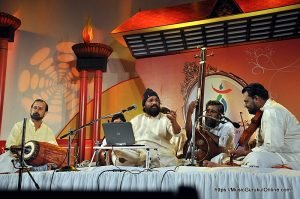Today we will talk about Raga Aadi of Indian Classical Music. Indian classical music is a rich and diverse musical tradition with a history that spans thousands of years. One of the key elements of Indian classical music is the concept of ragas, which are essentially melodic frameworks that form the basis of a musical composition. Raga Aadi is one such raga that has been an integral part of the Indian classical music tradition for many centuries.

Origins and Characteristics of Raga Aadi
Raga Aadi is a morning raga that belongs to the Kafi thaat, which is a group of ragas that share a similar melodic structure. The raga is believed to have originated in the southern Indian state of Tamil Nadu and is known by different names in different regions. In Tamil Nadu, it is known as Mohanam, while in the northern parts of India, it is called Bhairav.
The raga is characterized by a pentatonic scale (consisting of five notes) and has a simple and straightforward structure. It is usually performed in the morning hours and is believed to evoke feelings of devotion, peace, and serenity in the listener. The raga has a slow tempo and is often accompanied by the tabla and the tambura, which provide the rhythmic and harmonic support for the melody.

The Melodic Structure of Raga Aadi
The melodic structure of Raga Aadi is based on the pentatonic scale and follows a simple ascending and descending pattern. The raga is characterized by the following notes: Sa, Re, Ga, Pa, and Dha. The ascending pattern of the raga is as follows: Sa, Re, Ga, Pa, Sa. The descending pattern of the raga is as follows: Sa, Pa, Ga, Re, Sa.
The raga is often performed in a slow tempo, allowing the musician to explore the different nuances and subtleties of the melody. The use of glissandos (sliding from one note to another) and meends (a type of ornamentation) are common in Raga Aadi, and add to the overall beauty and expressiveness of the raga.

The Emotional and Spiritual Significance of Raga Aadi
Raga Aadi is believed to have a profound emotional and spiritual significance, and is often used in devotional music and bhajans (religious songs). The raga is said to evoke feelings of devotion, peace, and tranquility, and is often performed in temples and other places of worship.
The raga is also associated with the Hindu god Shiva, who is considered the lord of music and dance in Hindu mythology. According to legend, Shiva is said to have created the first musical instrument, the veena, and is believed to have imparted the knowledge of music to the world.

Raga Aadi is a beautiful and evocative raga that has been an integral part of the Indian classical music tradition for many centuries. Its simple and straightforward structure, combined with its emotional and spiritual significance, make it a popular choice for both musicians and listeners alike. Whether performed in a temple or a concert hall, Raga Aadi has the power to transport the listener to a place of peace and tranquility, and is a testament to the timeless beauty of Indian classical music.
See more:
